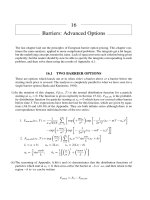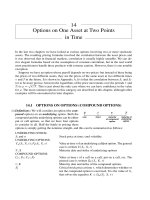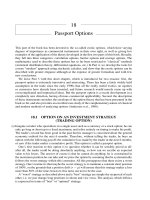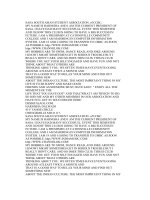Asian Options
Bạn đang xem bản rút gọn của tài liệu. Xem và tải ngay bản đầy đủ của tài liệu tại đây (297.65 KB, 16 trang )
17
Asian Options
17.1 INTRODUCTION
(i) Consider a company which is exporting goods continuously rather than in large chunks. Equal
payments are received daily in foreign currency and the exporter decides to hedge these for
the next month by buying put options. Compare the following two strategies: (i) the exporter
buys a set of put options with strike X, maturing on each day of the month; or (ii) he buys a
put option on the average exchange rate over the month with payoff max[0, X − Av].
Clearly, the payoff of package (i) is greater than that of package (ii): simply imagine two
successive days on which the exchange rates are X − 10 and X + 10. The combined payoff
for two separate puts would be 10 while the payoff for the put on the average price is zero.
An exporter is more likely to be interested in the average exchange rate rather than the rate on
individual daily payments. He would therefore execute the cheaper strategy (ii) above.
Options in which the underlying asset is an average price are known as Asian options. They
are of most interest in the foreign exchange markets, although they do appear elsewhere, e.g.
savings products whose upside return is related to the average of a stock index. In the following,
we will continue to use the vernacular of equity derivatives.
(ii) Average Price and Average Strike: There are two families of Asian options to consider:
r
Average price options with payoffs for call and put of
max[0, Av
T
− X ] and max[0, X − Av
T
]
r
Average strike options with payoffs
max[0, S
T
− Av
T
] and max[0, Av
T
− S
T
]
Average price options are more intuitively interesting and more common, although the two
types are obviously closely related. Both will be examined in this chapter.
(iii) In-progress and Deferred Averaging: The underlying “asset” in an Asian option is Av
T
, the
average price up to maturity at time T. This is not a tangible asset that can be delivered at
the expiry of an option, so these options are cash settled, i.e. an amount of cash equal to the
mathematical expression for the payoff is delivered at maturity.
It very often happens that the averaging period does not run from “now” to time T.Two
cases need to be considered:
r
We may be pricing an option that started at some time τ in the past and the averaging may
already have started.
r
The option may be only partly Asian, i.e. the averaging does not start until some time τ in
the future.
(iv) Definition of Averages: The average of a set of prices is most simply defined as A
N
=
(N + 1)
−1
N
n=0
S
n
. If the averaging does not start until n = ν (deferred averaging of the last
17 Asian Options
subsection, then A
N
= (N − ν + 1)
−1
N
n=ν
S
n
. Averaging could be calculated daily, weekly
or whatever is agreed. This is the arithmetic average and is used for most option contracts. The
various S
n
are lognormally distributed, but there is no simple way of describing the distribution
of A
N
. Note that by convention, the average includes the price on the first day of averaging,
e.g. it would include today’s price S
0
if averaging started now.
An alternative type of average, defined by G
N
={S
0
× S
1
×···×S
N
}
1/(N +1)
, is called
the geometric average. For deferred start averaging, G
N
={S
ν
× S
ν+1
×···×S
N
}
1/(N −ν+1)
.
Taking logarithms of both sides gives
g
N
= ln
G
N
S
0
=
1
N + 1
N
n=0
ln S
n
=
1
N + 1
N
n=0
x
n
The x
n
are normally distributed (see Section 3.1) and we know that the sum of normal random
variables is itself normally distributed; the distribution of g
N
is therefore normal.
(v) Geometric vs. Arithmetic Average: We have the unfortunate situation where options
in the market are all written on the arithmetic average while pricing is only easy for
the geometric average. Perhaps there is a simple bridge to get from one to the other?
On the right is a set of 20 daily prices of a commodity with a volatility of about 22%.
The arithmetic and geometric averages are A
20
= 103.95 and G
20
= 103.92, which
are surprisingly close given the very different mathematical forms of the two averages.
Given the simplifying assumptions of option theory and the uncertainty surrounding
volatility, one is tempted to say that these results are close enough to be taken as being
the same.
Could these two averages have come out close by accident? There is a mathematical
theorem which states that G
N
≤ A
N
always; equality occurs if all the S
n
are identical.
The commodity prices in our list are close in size so the averages are close. Now
consider two series in which the numbers being averaged are much more variable, or
equivalently stated, prices which are much more volatile:
1
20
{1 + 2 +···+20}=10.5; {1 × 2 ×···×20}
1
20
= 8.3
100
102
99
100
102
101
103
104
103
104
107
106
107
105
104
107
108
106
107
104
Even in this case, which is more extreme than price series generally encountered in finance,
the difference is only about 25%. It is frustrating to have the arithmetic and geometric results
so close, and we describe below how theoreticians have been prompted to devise schemes in
which an arithmetic option is regarded as a geometric option plus a correction factor.
(vi) Put–Call Parity: Before turning to various explicit models, it is worth pointing out that put–call
parity works for European Asian options – strange terminology, but meaning an average option
with no payout before final maturity permitted. For either a geometric or an arithmetic average
price, we may write
C
av
(T ) − P
av
(T ) = Av
N
− X
Taking risk-neutral expectations and present valuing gives
C
av
(0) − P
av
(0) = e
−rT
{E[Av
N
] − X}
202
17.2 GEOMETRIC AVERAGE PRICE OPTIONS
which gives the price of an Asian put option in terms of the price of the corresponding call
option. Expressions for EAv
N
with different averaging periods can be calculated exactly for
both geometric and arithmetic averages. This result means that we can focus on call options,
as the put price follows immediately from the above formula.
17.2 GEOMETRIC AVERAGE PRICE OPTIONS
(i) Use of Black Scholes Model for Geometric Average Options: The notation of Chapter 3 is
used and extended for simple or deferred geometric averaging as follows:
r
n
= ln
S
n
S
n−1
E[r
n
] = mδT var[r
n
] = σ
2
δT
Underlying price: S
n
Geometric average price: G
n
x
n
= ln
S
n
S
0
g
n
= ln
G
n
G
0
E[x
n
] = mT E[g
n
] = m
g
T
var[x
n
] = σ
2
T var[g
n
] = σ
2
g
T
E[S
n
] = S
0
e
(m+
1
2
σ
2
)T
= F
0T
E[G
n
] = G
0
e
(m
g
+
1
2
σ
2
g
)T
g
n
is normally distributed so we can take over the whole barrage of the Black Scholes model
to price geometric average price options, using the following substitutions:
r
S
N
→ G
N
; x
N
→ g
N
r
σ
2
→ σ
2
g
(17.1)
r
µ
risk neutral
= (r − q) → µ
g
= m
g
+
1
2
σ
2
g
(17.2)
Remember, the term (r − q) only appears in the Black Scholes model as an input into the calcu-
lation of the forward rate F
0T
→ S
0
e
(r−q)T
; so equation (17.2) is equivalent to the substitution
F
0T
→ S
0
e
(m
g
+
1
2
σ
2
g
)T
when using the Black Scholes model. Alternatively, we can describe the
substitutions in the Black Scholes model as
r
S
0
→ S
0
; σ
2
→ σ
2
g
; q → q
g
= r − m
g
−
1
2
σ
2
g
(17.3)
It just remains to work out expressions for m
g
and σ
2
g
. The form of these depends on the precise
averaging period being considered and will be given in the next three subsections.
(ii) Simple Averaging: We first consider geometric averaging from now until maturity, i.e. neither
deferred nor in progress. Using previous definitions in this chapter:
G
N
S
0
=
1
S
0
{S
0
× S
1
×···×S
N
}
1
N +1
=
S
0
S
0
×
S
1
S
0
×···×
S
N
S
0
1
N +1
Take logarithms of both sides:
g
N
=
1
N + 1
N
n=0
x
n
(17.4)
Using the analysis and notation of Section 3.1(ii) we can further write
x
n
= ln
S
n
S
0
= ln
S
1
S
0
×
S
2
S
1
×···×
S
n
S
n−1
= r
1
+ r
2
+···+r
n
203
17 Asian Options
All the r
i
are independently and identically distributed with E[r
i
] = mδT and var[r
i
] = σ
2
δT .
When taking expectations or variances of x
n
we can therefore simply write each of the r
i
as r
and put x
n
→ nr.
E[g
N
] =
1
N + 1
N
n=0
E[x
n
] =
1
N + 1
N
n=0
E[r
1
+ r
2
+···+r
n
]
=
1
N + 1
N
n=0
E[nr] =
mδT
N + 1
N
n=0
n
And similarly
var[g
N
] =
1
(N + 1)
2
N
n=0
var[x
n
] =
1
(N + 1)
2
N
n=0
var[nr] =
σ
2
δT
(N + 1)
2
N
n=0
n
2
The following two standard results of elementary algebra
N
n=1
n =
1
2
N (N + 1);
N
n=1
n
2
=
1
6
N (N + 1)(2N + 1)
are used to give
m
g
T = E[g
N
] =
1
2
mNδT =
1
2
mT
σ
2
g
T = var[g
N
] =
σ
2
N δT
3
(2N + 1)
(2N + 2)
=
σ
2
T
3
(2N + 1)
(2N + 2)
(17.5)
It is interesting to compare these last two results with the analogous results for the logarithm
of the stock price x
N
[Section 3.1(ii)]:
r
E[x
N
] = mT while E[g
N
] =
1
2
mT. It is no surprise that the expected growth of the average
is half the expected growth of the underlying.
r
lim
N→∞
var[g
N
] = σ
2
T /3. This is the “square root of three” rule of thumb for roughly
estimating the value of an Asian option from the Black Scholes model by dividing the
volatility by
√
3, which has long been used by traders.
(iii) Deferred Start Averaging: The results of the last subsection need to be adapted if the averaging
period is not from “now” to the maturity of the option. We assume that deferred start averaging
begins ν time steps from now. Equation (17.4) becomes
g
N
=
1
N − ν + 1
N
n=ν
x
n
Using the same analysis as before, we can write (for n ≥ ν)
x
n
= ln
S
n
S
0
= ln
S
ν
S
0
×
S
ν+1
S
ν
×···×
S
n
S
n−1
= x
ν
+ r
ν+1
+ r
ν+2
+···+r
n
204
17.2 GEOMETRIC AVERAGE PRICE OPTIONS
so that
E[g
N
] =
1
N − ν + 1
E
N
n=ν
{
x
ν
+ r
ν+1
+ r
2
+···+r
n
}
= E[x
ν
] +
1
N − ν + 1
N
n=ν+1
E[(n − ν)r]
Use E[x
ν
] = E[νr] = νmδT and
N
n=ν+1
(n − ν) =
N −ν
n=1
n in the last equation to give
E[g
N
] = νmδT +
mδT
N − ν + 1
1
2
(N − ν)(N − ν + 1) =
1
2
mδT (N + ν) (17.6)
The corresponding expression for variance is given by
var[g
N
] = var[x
ν
] +
σ
2
δT
(N − ν + 1)
2
N −ν
n=1
n
2
= σ
2
δT
ν +
1
6
(N − ν)(2N − 2ν + 1)
(N − ν + 1)
(17.7)
In continuous time, with large N and setting N δT → T and νδT → τ , the last two equations
can be written
E[g
N
] =
1
2
m(T + τ); var[g
N
] =
σ
2
3
T + 2τ −
T − τ
2(N − ν + 1)
(17.8)
(iv) In-progress Averaging: At some point in its life, every Asian option becomes an in-progress
deal. The average then needs to be replaced by the average from now to maturity plus a
non-stochastic past-average part. The adaption is straightforward:
G
N
={S
−ν
× S
−ν+1
×···×S
0
×···× S
N
}
1
N +ν+1
=
¯
G
ν
N +ν+1
{S
0
× S
1
×···×S
N
}
1
N +ν+1
where
¯
G ={S
−ν×S
−ν+1
×···× S
−1
}
1/ν
is the geometric mean of those past stock prices which
have already been achieved. Using the methods of the last two subparagraphs, we have
g
N
=
ν
N + ν + 1
¯
g +
1
N + ν + 1
N
n=0
x
n
Using the results of subsection (ii) above immediately gives
m
g
T = E[g
N
] =
ν
N + ν + 1
¯
g +
N + 1
N + ν + 1
1
2
mT (17.9)
σ
2
g
T = var[g
N
] =
σ
2
T
6
(N + 1)(2N + 1)
(N + ν + 1)
2
(17.10)
In continuous time these are written
m
g
T =
τ
¯
g +
1
2
mT
T + τ
; σ
2
g
T =
σ
2
T
3
T
T + τ
2
(17.11)
205
17 Asian Options
17.3 GEOMETRIC AVERAGE STRIKE OPTIONS
The payoff of a call option of this type is max[0, S
T
− G
T
]; but this is an option to exchange
one lognormal asset for another, and can be priced by Margrabe’s formula [equations (12.1)]
using the substitutions of equation (17.3):
C
GAS
= S
0
e
−qT
N[d
1
] − S
0
e
−q
g
T
N[d
2
] (17.12)
d
1
=
1
g
√
T
ln
e
−qT
e
−q
g
T
+
1
2
2
g
T
; d
2
= d
1
−
g
√
T
2
g
T = σ
2
T + σ
2
g
T − 2cov[x
T
, g
T
]; q
g
= r − m
g
−
1
2
σ
2
g
Expressions for m
g
and σ
2
g
corresponding to different types of averaging were derived in the
last section. Now we just need to derive an expression for the covariance term.
(i) Deferred Start Averaging: Recall the results from Section 17.2(iii):
g
N
=
1
N − ν + 1
N
n=ν
x
n
; x
n
= r
1
+ r
2
+···+r
ν
+···+r
n
and
cov[r
i
, r
j
] =
σ
2
δTi= j
0 i = j
to give cov[x
N
, x
n
] = nσ
2
δT (n ≤ N ). Then
cov[x
N
, g
N
] =
1
N − ν + 1
cov
x
N
,
N
n=ν
x
n
=
σ
2
δT
N − ν + 1
N
n=ν
n = σ
2
δT
N + ν
2
This last may be written σ
2
(T + τ )/2 in continuous time, and using equation (17.8) for σ
2
g
gives
2
g
=
σ
2
3
T − τ
T
(ii ) In-progress Averaging: Using the notation of Section 17.2(iv), cov
¯
g, x
N
=0 so that
cov[g
N
, x
N
] =
1
N + ν + 1
cov
N
n=0
x
n
, x
N
=
σ
2
δT
N − ν + 1
N
n=0
n = σ
2
δT
N (N + 1)
2(N + ν + 1)
Once again, the last expression can be written as σ
2
T
2
/2(T + τ ) which yields the slightly
more complicated result
2
g
= σ
2
T
2
3(T + τ )
2
+
τ
T + τ
17.4 ARITHMETIC AVERAGE OPTIONS: LOGNORMAL
SOLUTIONS
(i) The analysis of the last two sections on geometric Asian options is satisfyingly elegant; but
Asian options encountered in the market are arithmetic, and there are no simple Black Scholes
206









